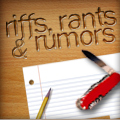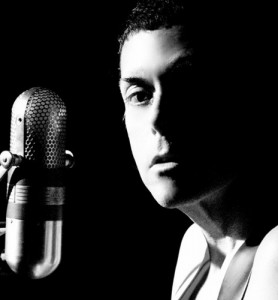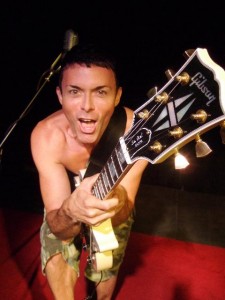Riffs, Rants & Rumors: Richard Barone Regains His 'Cool Blue Halo'
posted in: Artist Features • Exclusive Interviews • Features • Pop • Rock
 The rock world was getting ugly in 1987”the fresh fruit from the first half of the decade began to turn rancid as New Wave pioneers lost the plot and either fell apart or fatally tarted up their sound for more commercial appeal. Things were just as bad on the mainstream end of the spectrum as big-time rock acts got bigger and dumber, often simultaneously. But amid all the sonic Sturm und Drang, a soft, subtle little gem slipped in, showing that it was possible to turn people’s heads without blowing their ears out. And now, twenty-five years later, that unassuming classic is set for a rebirth.
The rock world was getting ugly in 1987”the fresh fruit from the first half of the decade began to turn rancid as New Wave pioneers lost the plot and either fell apart or fatally tarted up their sound for more commercial appeal. Things were just as bad on the mainstream end of the spectrum as big-time rock acts got bigger and dumber, often simultaneously. But amid all the sonic Sturm und Drang, a soft, subtle little gem slipped in, showing that it was possible to turn people’s heads without blowing their ears out. And now, twenty-five years later, that unassuming classic is set for a rebirth.
 Richard Barone, who had spent most of the ’80s making moody, mysterious power pop as the frontman for The Bongos, ventured out on his own for the first time with Cool Blue Halo, an all-acoustic album recorded live in concert at New York’s intimate Bottom Line club. “I was trying to do something that was not the Bongos,” says Barone. “I didn’t want to replace my best friends, so I didn’t go look for a bass player or drummer, I just tried to be open to other ideas.” The personnel for Barone’s new project fell into place with very little effort”he found cellist Jane Scarpantoni playing solo cello for the lunchtime crowd at Maxwell’s, the Hoboken club that had been The Bongos’ home base. Barone had just produced acoustic guitarist Nick Celeste‘s band, In Color, and the last piece of the puzzle fell into place when someone recommended Valerie Naranjo, who played both African and symphonic percussion.
Richard Barone, who had spent most of the ’80s making moody, mysterious power pop as the frontman for The Bongos, ventured out on his own for the first time with Cool Blue Halo, an all-acoustic album recorded live in concert at New York’s intimate Bottom Line club. “I was trying to do something that was not the Bongos,” says Barone. “I didn’t want to replace my best friends, so I didn’t go look for a bass player or drummer, I just tried to be open to other ideas.” The personnel for Barone’s new project fell into place with very little effort”he found cellist Jane Scarpantoni playing solo cello for the lunchtime crowd at Maxwell’s, the Hoboken club that had been The Bongos’ home base. Barone had just produced acoustic guitarist Nick Celeste‘s band, In Color, and the last piece of the puzzle fell into place when someone recommended Valerie Naranjo, who played both African and symphonic percussion.
Though The Bongos were never to release another album, they were still touring at this time, and the kind of quiet, folk-pop magic the Cool Blue Halo band began weaving in its performances made for some serious schizophrenia within Barone’s otherwise amped-to-eleven world. “This was like playing hooky from The Bongos,” Barone recalls. “I was doing the Richard Barone Cool Blue Halo shows and then the next night sometimes performing a Bongos show somewhere. And they were very opposite kinds of energy completely. Ivan Julian [of Richard Hell & The Voidoids] was playing with The Bongos at that time, so the band was really high-powered…It was a blurry period for me.”
 The performance you hear on Cool Blue Halo was the first time the foursome had ever performed in public together, Naranjo having joined the band a week before, and the new lineup squeezing in only a single rehearsal before the Bottom Line show. “There’s so much improvisation in that album,” remembers Barone, “because we hadn’t really played as a quartet before until that show. There’s something magical about that for me. I don’t know how we pulled it off.” In keeping with Barone’s vow to diverge from the beat-driven rock of The Bongos, this group took a much more abstract approach to rhythm. “Cool Blue Halo doesn’t really have any backbeat,” explains Barone, “That was one of the rules on that album…it’s all around the beat on the percussion.”
The performance you hear on Cool Blue Halo was the first time the foursome had ever performed in public together, Naranjo having joined the band a week before, and the new lineup squeezing in only a single rehearsal before the Bottom Line show. “There’s so much improvisation in that album,” remembers Barone, “because we hadn’t really played as a quartet before until that show. There’s something magical about that for me. I don’t know how we pulled it off.” In keeping with Barone’s vow to diverge from the beat-driven rock of The Bongos, this group took a much more abstract approach to rhythm. “Cool Blue Halo doesn’t really have any backbeat,” explains Barone, “That was one of the rules on that album…it’s all around the beat on the percussion.”
Barone also decided to honor a few of his key influences, but in unexpected ways. “I thought I should do a Beatles song, but I had to find the most obscure one I could¦I always loved ‘Cry Baby Cry’ from the White Album. I loved the way they did it, but I always felt like it was kind of an unfinished production¦I fleshed it out a little bit more, as far as the cello line and the marimba. And then I wanted to do a Marc Bolan song. I had already done ‘Mambo Sun’ with The Bongos, but I wanted to do a really obscure Marc Bolan song, so I did ‘The Visit.’ It’s about a love affair with an alien”I thought that was really romantic. And then I wanted to pick a Bowie song. At the time, ‘The Man Who Sold the World’ was very obscure, it had been covered only by Lulu in 1973, produced by David! I have the vinyl single of that. So I had Beatles, Bolan and Bowie. I couldn’t go wrong with that. And then I framed it, the first and last songs are Bongos songs. I kind of built a house with Cool Blue Halo where I had these pillars of the Beatles, Bowie, and Bolan in the middle holding it up, and the Bongos are the outside walls, and I could go in with my own new songs in between.”
The hushed and haunting sound the Cool Blue Halo band created might have been at odds with its era, but it had at least a partial precedent in the quietly elegant chamber-pop sounds of some of the 1960s’ more sophisticated bands. “The minor key feel of The Zombies and the harmonies of The Left Banke, those are in what we were doing,” Barone allows. “Never intentionally, because we weren’t, like, studying them, but it’s definitely in there.” In 1987, the approach was different enough to strike a chord with the curious, and the quartet spent the better part of the next two years touring in the US and Europe, even though the album’s American label, Passport, went under shortly after the record’s release. “We were still touring,” Barone recalls, “we didn’t really care, it went under and the copies were still floating around. It could have gotten around a lot more if the label didn’t die in the middle of the process, but in Europe it was on different labels, so that was fine.”
 But now Cool Blue Halo is about to have a second life in time for its twenty-fifth anniversary, as a deluxe, expanded, five-disc box set. Barone says the idea came from author and music executive Jay Frank, who’d been getting set to start a new label. “When he said five discs, I was taken aback at first, but then I realized that there are five discs here. One is the original album, which we’ll have to remaster. I think it’s gonna reveal a lot more of the detail of that album when we put it back up on the machine. Then I think we’ll do Live in Berlin for the live album, it’s a different show completely, even though it’s the same songs. Also on that same second disc could be Live in Paris. Then there’s the demos; I did make demos for the musicians on multitrack cassette, that’ll be an outtakes disc”demos and recordings that we did to learn the songs. And there are rare videos from the era, that’ll be on the outtakes disc as well. Then on May 4 at [New York club] City Winery we’re gonna do a new show, we’re gonna recreate the album, but with special guests. That will be recorded as an audio disc, and it’ll be filmed with several cameras. One of the discs will be the DVD. Then there’s also vinyl, there will be a single, that’s the fifth disc.”
But now Cool Blue Halo is about to have a second life in time for its twenty-fifth anniversary, as a deluxe, expanded, five-disc box set. Barone says the idea came from author and music executive Jay Frank, who’d been getting set to start a new label. “When he said five discs, I was taken aback at first, but then I realized that there are five discs here. One is the original album, which we’ll have to remaster. I think it’s gonna reveal a lot more of the detail of that album when we put it back up on the machine. Then I think we’ll do Live in Berlin for the live album, it’s a different show completely, even though it’s the same songs. Also on that same second disc could be Live in Paris. Then there’s the demos; I did make demos for the musicians on multitrack cassette, that’ll be an outtakes disc”demos and recordings that we did to learn the songs. And there are rare videos from the era, that’ll be on the outtakes disc as well. Then on May 4 at [New York club] City Winery we’re gonna do a new show, we’re gonna recreate the album, but with special guests. That will be recorded as an audio disc, and it’ll be filmed with several cameras. One of the discs will be the DVD. Then there’s also vinyl, there will be a single, that’s the fifth disc.”
As if that wasn’t enough, extra enticements will include a t-shirt and a lithograph, as well as a hardcover book containing photos, essays, album reviews from the time and more, all in a limited edition of 1,000 numbered and signed sets. To help offset the cost of things like the multi-camera video shoot, there’s a pre-order site where fans can kick in to get one of several variations on the reissue package, from the remastered original album alone to the full-blown box set plus tickets to the City Winery show.
Ultimately, Barone”a hardcore record collector himself”wanted to create a collectible item on a par with the collectors’ pieces he personally cherishes. “Right now in my apartment I’m surrounded by collectible things from different artists that I’ve collected all my life,” he says. “I just want to make this as nice and beloved as those items I’ve collected. This is the right album to do it with, maybe because the label went under, maybe because it had a limited run in America, maybe that’s why it’s interesting now to bring it back in this way. It was thwarted when the label went under then, it didn’t really have a chance. So I think now maybe more people can have a chance to hear it.”
